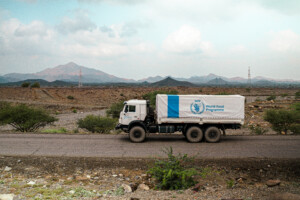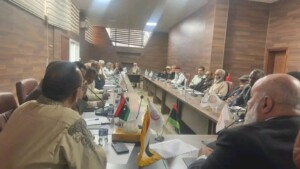Sudan OCHA bulletin 6: Staple food prices continue to increase following removal of wheat subsidies
Despite the above-average 2017/18 harvest, staple food prices continued to increase in Sudan during February 2018. This follows the removal of wheat subsidies and the devaluation of the Sudanese Pound in early 2018.

Despite the above-average 2017/18 harvest, staple food prices continued to increase in Sudan during February 2018. This follows the removal of wheat subsidies and the devaluation of the Sudanese Pound in early 2018.
In its latest biweekly bulletin, the UN Office for the Coordination of Humanitarian Affairs (OCHA) in Sudan quotes a recent FEWS NET report that retail millet and sorghum prices increased by 20 to 30 per cent between January and February in most markets. On average, current levels of retail staple food prices (sorghum, millet, and wheat) are two to three times higher than last year’s levels and the recent four-year average, according to FEWS NET.
In attempts to control the prices of staple foods and improve market access, the Strategic Reserve Corporation (SRC) of the Agricultural Bank of Sudan (ABS) is pre-positioning and selling subsidized sorghum in parts of Kassala and North Darfur affected by poor rains in 2017, and subsequent poor 2017/2018 harvest. Poor households in parts of Kassala and North Darfur who have been affected by below- average rains in 2017 are likely to continue to face Crisis – Integrated Food Security Phase Classification (IPC) Phase 3 – levels of food insecurity through May 2018. In response to this, the SRC has pre- positioned a total of 160,151 metric tons (MT) of sorghum in Kassala (11,430 MT) and North Darfur (10,930 MT), FEWS NET says.
Meanwhile, most areas of Sudan, are expected to continue facing Minimal (IPC Phase 1) or Stressed (IPC Phase 2) levels of food insecurity through September 2018, FEWS NET reports. However, most internally displaced persons (IDPs) in areas controlled by the Sudan People’s Liberation Movement – North (SPLM-N) in South Kordofan and IDPs in the Jebel Marra area of Darfur are likely to continue to face Crisis (IPC Phase 3) levels of food insecurity through May 2018. This is mainly due to their displacement, poor harvests or limited agricultural opportunities, and/or very high staple food prices. The food security among IDPs in SPLM-N areas of South Kordofan is likely to deteriorate further to Emergency (IPC Phase4) levels between June and September 2018. The UN Refugee Agency (UNHCR) in South Sudan reported in its latest operational update that 1,269 new arrivals from SPLM- N areas in South Kordofan were registered in Yida refugee settlement, Unity State (near the border with Sudan) during 1-15 March 2018. This represents 132 per cent increase compared to the same period last year when 545 new arrivals were registered. Food shortage in South Kordofan is the main driver for new arrivals, according to UNHCR.
Joint inter-agency assessment to Otash camp
A joint inter-agency mission was conducted to Otash IDP camp (5 km from Nyala town, South Darfur) on 20 March to assess the needs of some 1,200 IDPs displaced from the Tuwa area of East Jebel Marra due to internal fighting within the Sudan Liberation Army – Abdel Wahid (SLA-AW) in East Jebel Marra that occurred between November and December 2017. The mission included representatives of the government’s Humanitarian Aid Commission (HAC), the Office for the Coordination of Humanitarian Affairs (OCHA), the UN Children’s Agency (UNICEF), the World Food Programme (WFP), UNHCR, the UN Population Fund (UNFPA), the World Health Organization (WHO) and the national NGO Rehaid Elfursan Development Network.
According to the mission, the IDPs—the majority of whom are women and children—left behind their belongings, assets and livestock. The conflict also affected both their livelihoods and income generating activities. Their main needs are accessing water, food, emergency household supplies, as well as health, nutrition and education services. The mission also found that there are at least 300 children under the age of five and that diarrhoea and eye infections are the most common diseases affecting the children. The displaced reported that none of their children have been vaccinated due to lack of health services in their places of origin in the East Jebel Marra locality. The team recommended immediate vaccination of all these children in Otash camp, provision of emergency food assistance, shelter and non-food essential supplies after the International organization for Migration (IOM) completes the registration/verification process.
One of the largest camps in Darfur, Otash was established in 2004 to host IDPs from Otash and Ishma villages, from 2007 to 2017 more IDPs arrived in the camp from Al-Goz al-Gharbi, Wad Hajjam, and Muhajeria. Prior to the recent arrivals from East Jebel Marra, the camp hosted just over 80,000 IDPs.
Provision of non-food aid to South Sudanese refugees in Khartoum
UNHCR and the Commissioner of Refugees (COR) have launched a distribution campaign of non-food items to the South Sudanese refugees in the open areas in Khartoum. This includes plastic sheets and blankets to reinforce shelter. So far, the distribution has reached over 6,300 families (an estimated 31,500 people), with a total of 9,250 families (an estimated 46,250 people) targeted for the distribution, including 850 vulnerable host community households (an estimated 5,100 people).
Khartoum State hosts approximately 280,000 South Sudanese refugees, including more than 47,000 refugees who are staying in nine open areas within greater Khartoum, according to UNHCR.
Meanwhile, UNHCR and COR supported some 1,500 South Sudanese refugees (300 families) to relocate to Bileil IDP camp in South Darfur, where an estimated 3,500 South Sudanese refugees are currently living. These refugees had earlier settled on privately- owned land in Nyala and were issued an eviction notice by local authorities in early March. The refugees have been given land plots in Bileil camp and the international NGO Norwegian Church Aid (NCA) will extend their health service package to these new arrivals. UNHCR continues to call for consultative planning processes to settle refugees in a way that maintains their protection and dignity while addressing the concerns of private landowners.
According to UNHCR’s latest update on South Sudanese refugee response in Sudan, there are almost 768,000 South Sudanese refugees across Sudan, with Khartoum State having the largest caseload. For more information see the UNHCR operational update at this link.
UNHCR and COR support 3,518 Chadian refugees in Darfur to return home
As part of the ongoing voluntary repatriation process of Chadian refugees from two refugee camps in Central Darfur that commenced last December 2017, UNHCR and COR continue to assist Chadian refugees to return to their home country. So far, UNHCR and COR have supported 3,518 Chadian refugees, out of 8,400 refugees, to return in safety and dignity.
Convoys to transport the refugees to Moudeina, Chad, are departing from Um Shalaya refugee camp in Central Darfur every few days. The last convoy departed on 29 March and transported 330 refugees, and the next convoy is scheduled on 7 April 2018 from Mukjar camp, where all 477 refugees are registered to return. Thereafter the camp will be closed.
By the start of the rainy season in June, UNHCR plans to assist another 1,000 refugees to return to Chad. Refugees undergo medical screening and receive return packages prior to their departure from Central Darfur. Transportation is then provided to the refugees, along with their belongings and livestock to a reception centre in Moudeina, in eastern Chad, where they receive further reintegration assistance by UNHCR, the Government of Chad, and partners.
“After more than 10 years of exile in Sudan, UNHCR is pleased to provide Chadian refugees with solutions to their displacement”, said Ms. Noriko Yoshida, UNHCR Representative in Sudan.
The voluntary repatriation of Chadian refugees follows the signing of a tri-partite agreement in May 2017 between UNHCR and the Governments of Sudan and Chad, outlining key considerations for return.
“UNHCR is supporting both governments to ensure that refugees are well prepared for the return and reintegration process and that both their legal and physical protection needs are met”, added Ms Yoshida. “We also wish to extend our appreciation to the Government of Sudan and the host communities for their generosity towards the refugees”.
After the outbreak of violence in Chad from 2005 to 2007, Darfur has hosted refugees from Chad, with the majority now opting to return to their home country as a durable solution.
Those who remain in Darfur will continue to benefit from the principles of international protection. UNHCR and partners will continue to provide services and assistance in the camps in 2018.
Japan donates $1.2 million to assist returnees, refugees, IDPs and host communities in Sudan
The Government of Japan announced on 22 March their allocation of US$1.173 million to IOM for assistance to returnees, South Sudanese refugees, IDPs and host communities in Sudan. About $600,000 will go towards supporting the reintegration project in North and South Darfur states, and $573,000 for community stabilization as part of the Humanitarian and Development Nexus project in West Kordofan, according to a press release issued by IOM.
The funds will support South Sudanese refugees, IDPs and the host community to improve their access to basic services, whilst restoring the productive capacities of communities and income generation activities. The project aims to bridge the transitional gap between humanitarian and development interventions through a multi-sectoral response including, Displacement Tracking Matrix (DTM), water, sanitation, hygiene, health and livelihood assistance.
Under the reintegration project, the funds will enable support to the return and reintegration of IDPs and Sudanese refugees returning from neighbouring countries such as Chad and Central African Republic to El Fasher rural area (North Darfur) and Um Dafog locality (South Darfur). This would be accomplished through improved access to basic services, community infrastructure and livelihood activities.
All interventions will support a process of dialogue and foster acceptance amongst the different community members. The community will be brought together in an enabling environment to address the root causes of conflict and to foster community stabilization and social cohesion.
Japan supports UN Habitat to assist refugee and host communities
Japan is also supporting UN Habitat to launch the project entitled ‘Support to Hosting Communities Affected by South Sudanese Refugees in White Nile State.’ The project aims to deliver safe, clean and accessible market places as centres for hosting communities and South Sudanese refugees in Aljabalain locality in White Nile State that prevent the spread of diseases, including Acute Watery Diarrhoea (AWD). The project will enhance the self-reliance of both the hosting communities and South Sudanese refugees, particularly youth and women, through on-the-job training while improving market places in Aljabalain.
UN Habitat underlined the challenge in Sudan of responding to the large number of IDPs, refugees and returnees, who need urgent humanitarian assistance, durable solutions and development support. In addition, the refugee influx from South Sudan—of whom a large number are temporarily accommodated in White Nile State—are adding pressure on available basic services and resources, according to UN Habitat.











 and then
and then